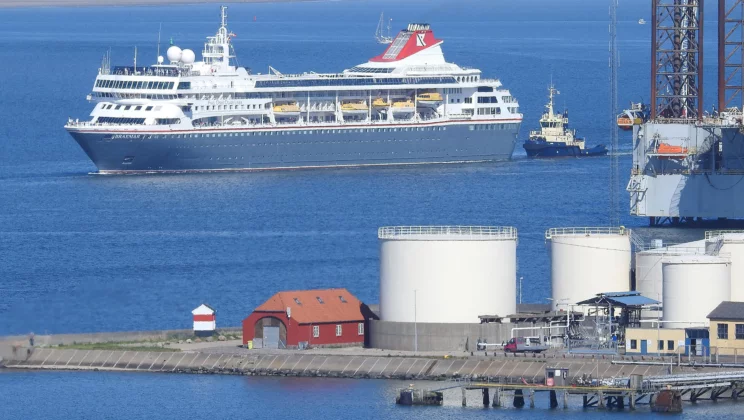New report finds that LNG is an interesting fuel with global growth potential, but also that so far the demand is limited in the small and medium-sized ports.
It sounds fascinating. One of the world's leading consulting firms in the energy sector, Westwood Global Energy Group, is expecting a turnover of USD 236 billion in the global LNG market from 2018 to 2022. That is 14% growth compared with the past five years.
But a new report prepared for the Port of Esbjerg in connection with an EU project dealing with green cruise tourism shows that it would be inappropriate to invest in LNG at the Port of Esbjerg at the current time.
"The conclusion is clear. LNG is interesting, but it is still too early for the Port of Esbjerg," says Peter Harbo, business development manager at the Port of Esbjerg.
The report was prepared by COWI, which consulted with the gas consulting firm Kosan Crisplant and others. The project is part of the 'Green Cruise Port' (see fact box), and COWI has studied how the LNG market will evolve in the years ahead throughout the entire Baltic region. In this context, they have created various business cases for the Port of Esbjerg.
"LNG is a more eco-friendly and natural fuel, and it makes good sense to use it in some sectors. But it requires huge investments and no one will make them in Esbjerg until demand is present," says Peter Harbo.
Depending on the type of plant to be built at the port, the price could quickly reach EUR 10 million. It is not easy to cool down and liquefy the gas and keep it in its liquid form, which makes it 600 times more concentrated.

LNG is liquified natural gas. When natural gas and methane are cooled to -161 °C, the gas liquifies, the density is increased by 600 times, and the natural gas therefore fills 600 times less and requires significantly less storage space in its liquid form. Condensed natural gas is called Liquified Natural Gas, LNG. Source: dcg.dk etc.
LNG is used by only a few ships in Esbjerg
At the moment, LNG is used only by some of the big cruise ships that enter Copenhagen, Amsterdam, Barcelona and other ports, but not the small ships that call at Esbjerg. At the same time, the cruise ships that actually call at Esbjerg are refuelled in other ports.
The report also reviews the demand for LNG for other than cruise ships.
According to the analysis, installation vessels for offshore wind farms, crew transfer vessels and offshore supply vessels that currently sail from Esbjerg will not be using LNG for the time being.
The technology is also in place to ensure that trucks and buses can run on LNG, but even here the report does not show great prospects:
"It is probably more likely that we will see more hybrid or hydrogen vehicles," says Peter Harbo.
In fact, in addition to COWI predicting limited demand for LNG in Esbjerg, a number of ports around Denmark already have LNG and facilities for production and LNG refuelling. There are LNG installations in Oslo, Gothenburg, Rotterdam, Zeebrugge and Hamburg.

LNG is currently only used by some of the major cruise ships that, but not the smaller ones calling Esbjerg.
Major international market
Recently, Shell estimated that by 2030, 20-30% of the total maritime fleet will sail on LNG.
Westwood Global Energy Group is a leading consulting company in market research and consulting services for the energy sector worldwide. They have just launched the World LNG Market Forecast, which analyses the market up to 2022 with in-depth studies on all existing LNG projects.
According to Westwood, the LNG sector is about to emerge from a difficult period in which reluctant investors and an oversupply of LNG have led to a number of cancelled projects. Now, the mood has changed.
"Although the oversupply still gives cause for concern, we anticipate great demand, especially in Asia, and stable demand in Europe. This means that the oversupply will be reduced over the next 5-7 years," says Mark Adeosun, Lead Analyst of Westwood Global Energy Group's research team.
"Many countries are looking at other forms of energy than the traditional ones. This has generated more projects in the pipeline. In 2050, CO2 consumption must be 50% lower, so there is pressure to deliver various solutions," says Mark Adeosun. That is why he is not quite as reticent about investing in Esbjerg as the report from COWI.
"If the right financial model is found, LNG in Esbjerg could be a good idea. It also depends on whether the Nord Stream 2 gas pipeline from Russia is delayed. If it is, then it might be interesting," says Mark Adeosun.
According to Westwood Global Energy Group, in the period up to 2022, 265 ships will be delivered worldwide that can transport LNG, and there will therefore be a record high number of transportation options by the time we reach 2022.
Two ways to deliver LNG
The LNG supply chain can be divided into two main groups. Either supply from a remote terminal, where the LNG is delivered to the port via trucks, containers or ships.
Or a permanent station at the port, which is a large investment, and requires greater strategic planning.
COWI has investigated 12 different permanent solutions in its report. The only solution with potential that they identify is that it may be an idea to provide ships with LNG if the refuelling takes place from a terminal in another port with LNG facilities. The refuelling has actually been performed at the Port of Esbjerg by driving tank vehicles up from Zeebrugge and refuelling directly from the vehicle to the ship.
"The problem with this way of doing things is just that when the LNG is transported by truck in this way, some of the green mindset and gains also disappear," says Peter Harbo.
The report also indicates that the development of batteries for ferries is progressing so rapidly that this would seem a realistic option in the future.
"At the moment, it appears that smaller ships and passenger ferries are more interested in electrical power than LNG," says Peter Harbo.
Go to overview

